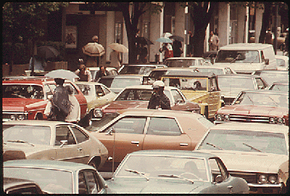U.S. Labor Law
The Wagner Act, also known as the National Labor Relations Act, still regulates most strikes and unions in the U.S. This act protects the rights of workers to discuss unions, form unions and take actions on union business. However, it doesn't necessarily protect them from the consequences of those actions. For example, a 1938 Supreme Court case ruled that employers can't fire workers for joining a union or going on strike. However, other workers can permanently replace them. Employers have to prove that they bargained in good faith and reached a deadlock with the union before they can do this, however.
The Taft-Hartley amendments of 1947 made some significant changes to the National Labor Relations Act. These laws established the National Labor Review Board (NLRB), a government body that hears grievances between unions and employers and makes decisions in an impartial manner. The Taft-Hartley amendments weakened unions to some extent, forbidding secondary boycotts (a strike against another business that works with the business targeted by the original strike) and closed shops (where union membership is an absolute requirement of employment). However, federal law still allows for union shops, in which a worker must join a union within 30 days of his hire date. Most states have passed "right to work" laws that forbid the union shop.
Advertisement
Not all workers have the same right to strike. Some unions voluntarily give up the right to strike in their contracts because they know that their services are too crucial for the public to tolerate a strike. Police officers and firefighters generally give up their right to strike. Instead, they agree to use arbitration, in which a neutral third party hears both arguments and makes a binding decision. Workers who are employed by the government don't always have the right to strike -- it depends on the particular union and field. For example, public school teachers can usually strike, but transit workers usually can't.
For lots more information on strikes, check out the links below.
Related HowStuffWorks Articles
More Great Links
- American History: Labor
- U.S. National Labor Relations Board
- The Railway Labor Act
- Wagner Act
- Key Work and Rent Strikes Around the World
- List of Labor Unions -- both U.S. and international
Sources
- Excerpts from the Trial of the Journeymen Cordwainers of Philadelphia (Commonwealth v. Pullis), 1806. http://64.233.179.104/search?q=cache:yGfYHtZvKHkJ: www.law.ucla.edu/students/ academicinfo/coursepages/s2001/337/cordwainerstrial.html +scabb%27d&hl=en&gl=us&ct=clnk&cd=1&client=firefox-a
- Forbes, Gordon. "'82 strike changed salary dealings forever." USA Today, June 8, 2001. http://www.usatoday.com/sports/comment/forbes/2001-06- 08-forbes.htm
- Lens, Sidney. "Strikemakers & Strikebreakers." Lodestar Books, 1985. 052567165x.
- NLRB v. Jones & Laughlin Steel Corp., 301 U.S. 1 (1937). U.S. Supreme Court Multimedia. http://www.oyez.org/oyez/resource/case/283/
- Smith, Robert Michael. "From Blackjacks to Briefcases." Ohio University Press, 2003. 0821414658.
- Stevens, Robert. "General strike in France as workers continue protests against Raffarin government." World Socialist Web Site, March 11, 2005. http://www.wsws.org/articles/2005/mar2005/fran-m11.shtml
- Swartz, Omar. "Defending Labor in Commonwealth v. Pullis: Contemporary Implications For Rethinking Community."Murdoch University Electronic Journal of Law, Volume 11, Number 1 (March 2004). http://www.murdoch.edu.au/elaw/issues/v11n1/swartz111_text.html
- Zinn, Howard et al. "Three Strikes." Beacon Press, 2001. 0807050121.
